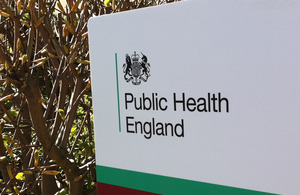Flu vaccine shows low effectiveness against the main circulating strain seen so far this season
Flu vaccination remains important for other strains that still may circulate this winter.

New research from Public Health England (PHE) has found that the seasonal influenza vaccine has provided low protection this winter against flu infection caused by one particular subtype, H3N2. This is because of a mismatch between the A(H3N2) strain selected for the vaccine this year and the main A(H3N2) strain that has been circulating in the UK this winter. The findings on mid-season flu vaccine effectiveness in the UK are published today in Eurosurveillence.
The research, based on the results from 1,314 patients presenting in primary care across the UK, found that vaccine effectiveness in preventing laboratory confirmed influenza was estimated to be 3% overall. This compares to approximately 50% vaccine effectiveness that has typically been seen in the UK over recent years.
This flu season has been dominated by circulation of influenza A(H3N2) subtype viruses, which cause particular problems for vulnerable groups such as the elderly and has resulted in care home outbreaks, hospitalisations and excess mortality in those over 65 years.
PHE has carefully examined some of the influenza A(H3N2) viruses circulating this season by antigenic and genetic analysis, and has found evidence of drift compared to the A(H3N2) virus strain in the flu vaccine. The low vaccine effectiveness that has been found shows that this drift has been significant and resulted in a mismatch to the vaccine strain.
The UK findings follow the recent publication of the US and Canada’s mid-season vaccine effectiveness estimates, both of which also revealed the vaccine had unfortunately provided little protection against circulating A(H3N2) viruses this season in these countries. This was also linked to drift observed in H3N2 viruses.
Study author, Dr Richard Pebody, PHE’s head of flu surveillance, said:
The World Health Organization monitors influenza globally and each year recommends the strains of flu virus that should be included in the flu vaccine for the forthcoming flu season. It takes from February through to August / September to produce sufficient quantities of the flu vaccine. If a change in the virus is detected once production has started it is not possible to change it.
Throughout the last decade, there has generally been a good match between the strains of flu in the vaccine and those that subsequently circulate, so it’s crucial that these results do not discourage people in at-risk groups from having flu vaccination now, or in the future.
The current vaccine is still expected to protect against flu A(H1N1)pdm09 and flu B, both of which may yet circulate this season, so anyone in an at-risk group should still get vaccinated if they have not already.
It’s not possible to fully predict the strains that will circulate in any given season, and there is always a risk of a drift occurring as we have seen this year. However, it’s important to be aware that this does not occur every season. Flu vaccine is still the best protection we have against an unpredictable virus which can cause severe illness and deaths each year among at-risk groups, including older people, pregnant women and those with a health condition, even one that is well managed.
Our findings also mean that the early use of antivirals to treat and help prevent serious cases of flu in vulnerable patients is even more important this season.
Deputy Chief Medical Officer John Watson said:
The latest data show that levels of flu are generally decreasing in the UK. We do see ‘drift’ in the flu virus from time to time, but even so, I want to reassure people that it is still the best overall way to protect yourself and your family from flu, along with good hand hygiene.
Antiviral drugs are available and effective, and doctors should prescribe them for those at greatest risk of becoming seriously ill due to flu.
In recent weeks, there have been indications that influenza activity is stabilising, but evidence of significant excess mortality, particularly in the elderly, continues to be seen, with more deaths than expected at this time of the year. This further highlights the importance of early prescribing of antivirals for vulnerable groups to reduce the risk of serious illness.
Ends
Notes to editors
-
PHE’s weekly flu report was published today, Thursday 5 February, and shows that levels of flu activity were at similar and/or lower levels than the previous week.
-
In common with Australia and counterparts from the US, PHE has previously reported differences between the A(H3N2) vaccine strain and the strain circulating this season, otherwise known as ‘vaccine drift’. The findings have shown the vaccine to be -2% (95%CI -56 to 33% effective against the drifted A(H3N2) strain of the virus, indicating low or no effect.
-
In the UK, influenza A(H3N2) is the predominant subtype circulating this season to date, and H3N2 viruses similar to A/Texas/50/2012 are the strains that the vaccine currently protects against. Analysis conducted by PHE has shown a large proportion of flu viruses circulating have shown evidence of either antigenic or genetic drift from A/Texas/50/2012, and were similar to another H3N2 strain; A/Switzerland/9715293/2013. The A/Switzerland/9715293/2013 strain has been recommended for inclusion in the southern hemisphere influenza vaccine to be used in 2015.
-
PHE exists to protect and improve the nation’s health and wellbeing and reduce health inequalities. It does this through advocacy, partnerships, world-class science, knowledge and intelligence, and the delivery of specialist public health services. PHE is an operationally autonomous executive agency of the Department of Health. www.gov.uk/phe Follow us on Twitter @PHE_uk
UKHSA press office: National Infection Service
UKHSA press office, infectious diseases
61 Colindale Avenue
London
NW9 5EQ